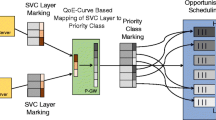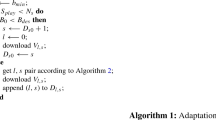Abstract
Recently using Scalable Video Coding (SVC) in Dynamic Adaptive Streaming of over HTTP (DASH) has attracted more and more attention. In this paper, we present a Quality-of-Experience (QoE) driven Cross-Layer Scheme (QCLS) for DASH-based scalable video transmission over LTE. Specifically, assuming the priority-based extraction be exploited for bitstream adaption, we first propose a new continuous Rate-Distortion (RD) model for scalable video stream. Then to guarantee continuous playback, a two-level rate adaption algorithm is presented: a novel throughput-based algorithm is implemented for dynamic selection of segment bitrate on the DASH client side at the first level, and the second level applies the rate adaption by designing a suitable packet scheduling strategy at the Base Station. The packets of each segment with lower priority that are still left in the packet queues when their playback deadline is missed, would be considered as the ones that are beyond the actual transmission ability and discarded by the second-level rate adaption. Furthermore, in order to reasonably utilize the wireless resources in LTE (Long-Term Evolution) system, a cross-layer optimization problem that maximizes the total weighted received quality of the currently transmitted segments for all clients is formulated. In view of its high complexity of obtaining the optimal solution, we develop an approach of the suboptimal solution, which can determine a locally optimal transmission strategy in resource allocation as well as the corresponding Modulation and Coding Scheme. Accordingly, the transmission rate of each client can be obtained. Simulation results show that our proposed cross-layer scheme can provide better performance than the existing ones for DASH-based scalable video transmission over LTE.













Similar content being viewed by others
References
3GPP (2008) Evolved universal terrestrial radio access (E-UTRA) and evolved universal terrestrial radio access network (E-UTRAN); overall description; stage 2, TS 36.300 V8.7.0
Andelin T, Chetty V, Harbaugh D, Warnick S, Zappala D (2012) Quality selection for dynamic adaptive streaming over HTTP with scalable video coding. In: Proc. ACM Multimedia Systems Conference (MMsys), pp 149–154
Basukala R, Ramli HM, Sandrasegaran K (2009) Performance analysis of EXP/PF and M-LWDF in downlink 3GPP LTE system. In: Proc. 1st AH-ICI, pp 1–5
Cheng XL, Mohapatra P (2012) Quality-optimized downlink scheduling for video streaming applications in LTE networks. IEEE Global Commun. Conf. (GLOBECOM), pp 1914–1919
Choi J-G, Bahk S (2007) Cell-throughput analysis of the proportional fair scheduler in the single-cell environment. IEEE Trans Veh Technol 56(2):766–778
Cicalò S, Tralli V (2014) Distortion-fair cross-layer resource allocation for scalable video transmission in OFDMA wireless networks. IEEE Trans Multimedia 16(3):848–863
de Oliveira DFB, Anelise Munarettoy, Artur Zivianiz, Mauro Fonseca (2009) A proxy-based architecture for TCP to mitigate packet loss on wireless networks. IEEE 2nd IFIP Wireless Days (WD)
Dianati M, Shen S, Naik S (2005) A new fairness index for radio resource allocation in wireless networks. IEEE Conf Wireless Commun Networking 2:712–717
Essaili AE, Schroeder D, Steinbach E, Staehle D, Shehada M (2014) QoE-based traffic and resource management for adaptive HTTP video delivery in LTE. IEEE Trans Circuits Syst Video Technol 988–1001
Fattah H, Alnuweiri H (2009) A cross-layer design for dynamic resource block allocation in 3G long term evolution system. IEEE 6th int. conf. mobile adhoc and sensor systems, pp 929–934
Guo J, Gong X, Liang J (2015) A hybrid transmission approach for DASH over MBMS in LTE network. IEEE global communications conference, pp 1–6
Guo Y, Yang Q, Kwak K (2016) Quality-oriented rate control and resource allocation in time-varying OFDMA networks. IEEE Trans Veh Technol 1–6
He LJ, Liu GZ (2014) Quality-driven cross-layer Design for H.264/AVC video transmission over OFDMA system. IEEE Trans Wirel Commun 13:6768–6782
Huysegems R, Vleeschauwer B, Wu T, Leekwijck W (2012) SVC-based HTTP adaptive streaming. Bell Labs Technical Journal 16(4):25–41
Ji X, Huang JW, Chiang M, Lafruit G, Catthoor F (2009) Scheduling and resource allocation for SVC streaming over OFDM downlink systems. IEEE Trans Circuit Syst Video Technol 19(10):1549–1555
Josep C, Martin W, Markus R (2010) System level simulation of LTE networks. IEEE 71st veh technol conf, pp 1471–1475
JSVM 9.19.11 Reference Software, Feb. 2011
Kela P, Puttonen J, Kolehmainen N, Ristaniemi T, Henttonen T, Moisio M (2008) Dynamic packet scheduling performance in UTRA long term evolution downlink. In: Proc. Int. Symp. Wireless Pervasive Computing(ISWPC), pp 308–313
Le HT, Nguyen DV, Ngoc NP, Pham AT, Thang TC (2013) Buffer-based bitrate adaptation for adaptive http streaming. In: Proc. IEEE ATC2013, HoChiMinh City, Vietnam
Li F, Liu GZ, He LJ (2009) Application-driven cross-layer approaches to video transmission over downlink OFDMA networks. IEEE Global Commun. (GLOBECOM) Workshops, pp 1–6
Lin YB, Chiu TH, Su YT (2009) Optimal and near-optimal resource allocation algorithms for OFDMA networks. IEEE Trans Wirel Commun 8(8):4066–4077
Liu C, Bouazizi I, Gabbouj M (2011) Rate adaptation for adaptive http streaming. In: Proc. of ACMMMSys
Liu Y, Dey S, Ulupinar F, Luby M, Mao Y (2015) Deriving and validating user experience model for DASH video streaming. IEEE Trans Broadcasting 61(4):651–665
Luo HY, Ci S, Wu DL, Wu JJ, Tang H (2010) Quality-driven cross-layer optimized video delivery over LTE. IEEE Commun Magazine 48:102–109
M. of WINNER (2005) Assessment of advanced beamforming and MIMO technologies. WINNER, Tech. Rep. IST-2003-507581
Mansour H, Fallah YP, Nasiopoulos P, Krishnamurthy V (2009) Dynamic resource allocation for MGS H.264/AVC video transmission over link-adaptive networks. IEEE Trans Multimedia 11(8):1478–1491
May Z, Mazliza O, Timothy O (2016) A proxy acknowledgement mechanism for TCP variants in mobile ad hoc networks. IEEE Journal of Communications and Networks 18(2):238–245
Meng S, Sun J, Duan Y, Guo Z (2016) Adaptive video streaming with optimized bitstream extraction and PID-based quality control. IEEE Trans Multimedia 18(6):1124–1178
Miller K, Quacchio E, Gennari G, Wolisz A (2012) Adaptation algorithm for adaptive streaming over http. In: Proc. Packet Video Workshop (PV 2012), pp 173–178
Pir G, Grieco LA, Boggia G, Fortuna R, Camarda P (2011) Two-level downlink scheduling for real-time multimedia services in LTE networks. IEEE Trans Multimedia 13(5):1052–1065
Romero LR (2011) A dynamic adaptive http streaming video service for google android. M.S. Thesis, Royal Institute of Technology (KTH)
Seema A, Schwoebel L, Shah T, Morgan J, Reisslein M (2015) WVSNP-DASH: name-based segmented video streaming. IEEE Trans Broadcasting 61(3):346–355
Tang TC, Le HT, Pham AT, Ro YM (2014) An evaluation of bitrate adaptation methods for HTTP live streaming. IEEE J Select Areas Commun 32(4):693–705
Tuomaala E, Wang H (2005) Effective SINR approach of link to system mapping in OFDM/multi-carrier mobile network. IEEE 2nd international conf. mobile technol. app. and systems
Ye Z, El-Azouzi R, Jimenez T, Altman E, Valentin S (2016) Backward-shifted strategies based on SVC for HTTP adaptive video streaming. IFIP Networking Conference (IFIP Networking) and Workshops, pp 494–502
Yin X, Jindal A, Sekar V, Sinopoli B (2015) A control-theoretic approach for dynamic adaptive video streaming over HTTP. ACM SIGCOMM Computer Communication Review 45(4):325–338
Zhao M, Gong X, Liang J, Wang W, Que X, Cheng S (2014) QoE-driven cross-layer optimization for wireless dynamic adaptive streaming of scalable videos over HTTP. IEEE Trans Circuits Syst Video Technol 451–465
Author information
Authors and Affiliations
Corresponding author
Rights and permissions
About this article
Cite this article
Deng, R., Liu, G. QoE driven cross-layer scheme for DASH-based scalable video transmission over LTE. Multimed Tools Appl 77, 6445–6469 (2018). https://doi.org/10.1007/s11042-017-4551-y
Received:
Revised:
Accepted:
Published:
Issue Date:
DOI: https://doi.org/10.1007/s11042-017-4551-y




